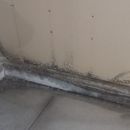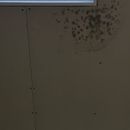Mold on garage drywall during winter
Hi,
I’ve search lot of forums regarding this but end up going in circles. Hope you guys can shed some light to my problem.
Live in canada where winter is always brutally cold. My problem is in my insulated unconditioned attached garage (used only for parking vehicles) where there is room on top of it.
Mold has got to my drywalls (bare no paint just screwed to the 2×4’s) from the garage footing freezing and thawing. Drywall resting on the garage footing so it’s sucking that water. And since we also parked our vehicles, we are dragging snow causing it to melting and freeze overnight might also contributed to it. My only way of drainage is opening the garage door and sweep the water outside.
Other said cut the bottom part of the drywall replace with treated wood and paint drywall with mold resistant primer. One said, install exhaust fan (bath fan) to ventilate and insulate garage footing cement with rigid foam. Another said put heater and that will solve my problem. Lots of options but can you point me in the right direction that really work for my situation. Attached are pics of the my garage with moldy drywall.
If installing exhaust fan is the best thing to do in my situation. i also attached pics for the possible install.
Thanks in advance for your help.
GBA Detail Library
A collection of one thousand construction details organized by climate and house part














Replies
Kraga, lots of issues for sure. First, very few builders ever put a moisture barrier/brake below the bottom wall plate and the foundation so water will seep up through the cement into the wall. It's not heated so always cold so moisture will always collect when dew point is right. Especially in summer when the bottom of the wall is cold and humid air condenses on the drywall and stays damp. Mold loves upper 30s to 50s Fahrenheit. Painting will only trap moisture under the surface. For sure you should not have anything in contact with the cement that can wick moisture. Air circulation helps but at cooler temps can increase condensation on the surface. Heating is very expensive in a non conditioned space. Do you really need the drywall on walls not directly attached to house?
Lots to consider, PK
I only insulated my garage walls (used roxul and vb) to at least be a little comfortable during brutal winters and not cause mold to the wood since my garage is tight and have room on top of it. Forgot to mention that there is no vent in my attached garage if it matters to my problem
Do you mean if i undo my insulation and drywall this will all go away? Or just take off the drywall and leave insulation and vb?
If i need to take off everything will gladly do so. Just don't want any molds to grow inside my garage because of room above it.
Thanks.
That mold seams to be at seams except for the photo with the large circle of mold. These are usually leaky points associated with warm moist air leaving the house in winter or coming from outside on warm humid days in summer and wetting the interior back side of the drywall. So air sealing is important but garages are unconditioned and never sealed. The ceiling below living space is most important usually never sealed & poorly insulated.
I think you need to do all of the things you mentioned . You need to be vigilant on squeegeeing out the water as often as necessary to keep that floor dryish. Does that window leak or get lots of ice? A heated garage is a wonderful thing.
Every winter that window freeze/ice up. When we start our vehicle to warm up it melts and the drywall acts as a basin catching all that water. Same thing happens when we get some nice weather.
We do open our garage door around 2 feet when we heat up the car inside. But we closed the door right away when coming from work dragging that ice inside and melts downs after a few minutes.
Drywall on the ceiling doesn't have any mold or anything, which is a good sign for me. It's was sealed and drywalled by the builder 2 years ago.
I have heard of using the relay in the garage door opener to run an exhaust fan on and of automatically.
Try one of those plastic heat shrink insulating kits on the inside of that window. I bet it makes a huge difference.
Adding a little heat to the garage will improve the house performance and you wont need to run the cars before you go in the morning.
Deleted
Can i use the extra vapour barrier i used to insulate the garage on the window or the heat shrink is much more better?
I'm actually set my eyes on panasonic bath fan with humidity control built in or any booster fan rig with leviton humidistat switch. But your idea seems much better.
For heat don't know if i can install one. we are i think by code only allowed here electric and i don't have 220 volt plug inside the garage.
Can i use a cement board at the bottom of the drywall i will cut or treated wood will be ok? As long as its not resting on my garage footing.